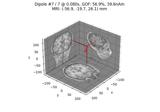mne.DipoleFixed¶
- class mne.DipoleFixed(info, data, times, nave, aspect_kind, comment='', verbose=None)[source]¶
Dipole class for fixed-position dipole fits.
Note
This class should usually not be instantiated directly, instead
mne.read_dipole()should be used.- Parameters
- info
mne.Info The
mne.Infoobject with information about the sensors and methods of measurement.- data
array, shape (n_channels, n_times) The dipole data.
- times
array, shape (n_times,) The time points.
- nave
int Number of averages.
- aspect_kind
int The kind of data.
- comment
str The dipole comment.
- verbosebool |
str|int|None Control verbosity of the logging output. If
None, use the default verbosity level. See the logging documentation andmne.verbose()for details. Should only be passed as a keyword argument.
- info
See also
Notes
This class is for fixed-position dipole fits, where the position (and maybe orientation) is static over time. For sequential dipole fits, where the position can change a function of time, use
mne.Dipole.New in version 0.12.
- Attributes
ch_namesChannel names.
Methods
__hash__(/)Return hash(self).
copy()Copy the DipoleFixed object.
plot([show, time_unit])Plot dipole data.
save(fname[, verbose])Save dipole in a .fif file.
shift_time(tshift[, relative])Shift time scale in epoched or evoked data.
- property ch_names¶
Channel names.
- copy()[source]¶
Copy the DipoleFixed object.
- Returns
- instinstance of
DipoleFixed The copy.
- instinstance of
Notes
New in version 0.16.
- plot(show=True, time_unit='s')[source]¶
Plot dipole data.
- Parameters
- Returns
- figinstance of
matplotlib.figure.Figure The figure containing the time courses.
- figinstance of
Examples using
plot:
- save(fname, verbose=None)[source]¶
Save dipole in a .fif file.
- Parameters
- fname
str The name of the .fif file. Must end with
'.fif'or'.fif.gz'to make it explicit that the file contains dipole information in FIF format.- verbosebool |
str|int|None Control verbosity of the logging output. If
None, use the default verbosity level. See the logging documentation andmne.verbose()for details. Should only be passed as a keyword argument. Defaults to self.verbose.
- fname
- shift_time(tshift, relative=True)[source]¶
Shift time scale in epoched or evoked data.
- Parameters
- tshift
float The (absolute or relative) time shift in seconds. If
relativeis True, positive tshift increases the time value associated with each sample, while negative tshift decreases it.- relativebool
If True, increase or decrease time values by
tshiftseconds. Otherwise, shift the time values such that the time of the first sample equalstshift.
- tshift
- Returns
- epochsinstance of
Epochs The modified Epochs instance.
- epochsinstance of
Notes
This method allows you to shift the time values associated with each data sample by an arbitrary amount. It does not resample the signal or change the data values in any way.
